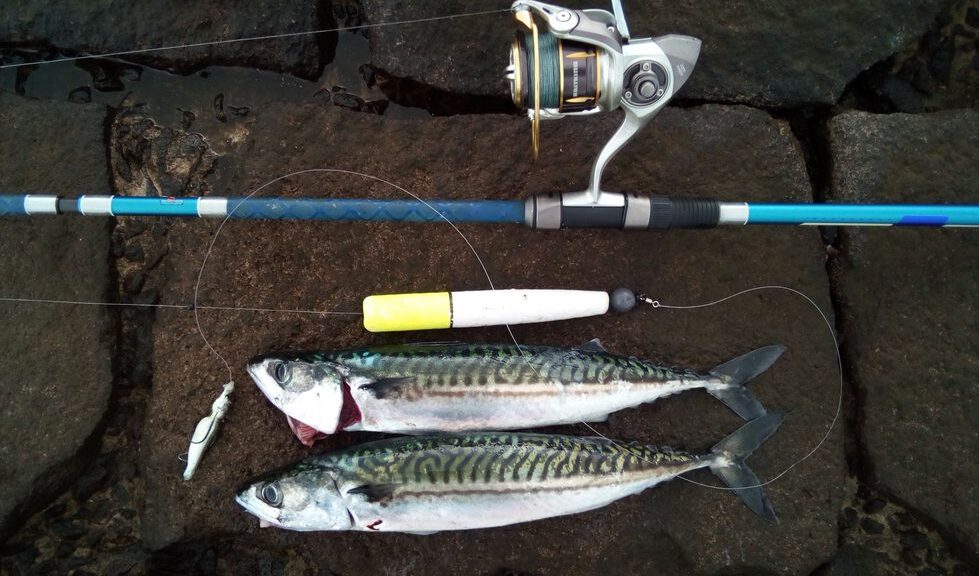
Mackerel fishing – 5 ways to catch mackerel
Fishing for mackerel is one of the most enjoyable summer pastimes. Ounce for ounce the mackerel is one of the hardest fighting saltwater species. Targeting mackerel with feathers is probably the most well-known method but other methods can be very effective too. It all depends on the conditions and what you want to achieve. Do you want to stock up your freezer quickly or do you want to have some fun? In this blog post I describe 5 methods I use to catch mackerel, each with their pros and cons.
1. Mackerel fishing with feathers
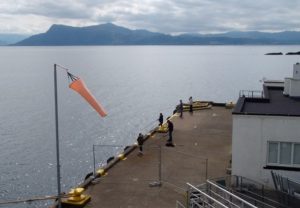
Targeting mackerel with feathers or daylights can be extremely effective. All you need is a sturdy rod, weights and some feather rigs. A set of feathers imitates a shoal of bait fish. A “pull and wind” retrieve gives the best action. Simply lift the rod upwards to move the feathers up, then point the rod forward while you reel in the slack line. Repeat until you hit a shoal of mackerel. These are the feathers I use most of the time. But you can also make your own, as shown in this video.
Pros
- If the mackerel are there in numbers you can catch vast quantities in very little time. Great when you’re planning a barbecue or need to stock up on bait.
- No need to bring any bait.
- Depending on the weights and rod you use you can cover a lot of ‘ground’.
Cons
- In snaggy areas you will lose a lot of tackle. Nothing gets snagged as easily as 4 or more hooks on a trace.
- You don’t experience the mackerel’s true fighting potential. One mackerel on light tackle fights a lot harder than six of them on beach caster.
- This type of fishing can get repetitive pretty fast whether you’re catching or not.
- Not very catch and release friendly, especially when you’re fishing from a high structure, like a pier. So make sure you really need all those fish. (More about handling mackerel later.)
2. Float fishing for mackerel
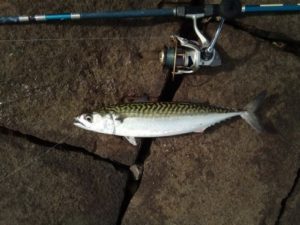
My favourite way of catching mackerel is with a float. Nothing beats the excitement of a float disappearing underwater. It also means you can fish with light gear which makes catching mackerel a lot more fun. For detailed information on float fishing in the sea, please read this post. The float I use most of the time is this one.
Pros
- You can cover large areas. Just let the tide take your float.
- You can adjust the depth until you find the fish.
- Great sport, especially when you use light tackle.
- You get snagged a lot less, making this a perfect method for rough ground fishing.
- Interesting by-catches like pollock and garfish.
Cons
- You need to take bait with you (I recommend sprats). No need to take loads of bait though, because as soon as you catch one mackerel you have plenty of bait for the day (mackerel strips are a great float fishing bait).
- You can only catch one fish at a time, unless you use the method described below.
Multi-hook mackerel float rig
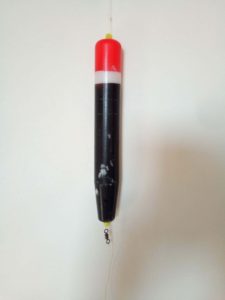
I don’t use this rig very often because I prefer to fish light, but it can be a real killer when there are loads of mackerel around. For this method you need a float that will take a 3 or 4oz lead. Use the float rig set up as described in this post but without the bullet weight. Slide a bead underneath the float and attach a feather trace to your mainline (as shown in the picture). Clip the desired weight to the lead clip, bait the feathers with mackerel strips or sprats and you’re ready to go. You don’t have to use a feather rig of course. You can also tie a multi-hook trace with the method described below (method 4).
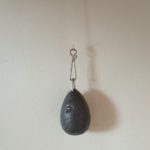
This method works best with a bass rod or light beach caster. It’s the perfect method when you want to catch some mackerel for bait quickly. Most of the time the mackerel will hook themselves against the buoyancy of the float.
3. Spinning for mackerel
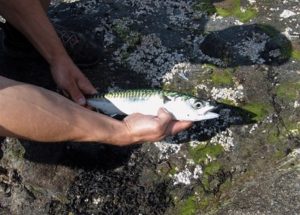
Spinning is another great method to catch mackerel. No need to take loads of gear: a box of lures, a spinning rod and a reel are all you need. Balance the tackle right and it’s like catching mini-tuna. Of course the tackle you use strongly depends on the distance you need to reach the fish. If they’re under your feet, LRF or perch tackle provide the most fun. But if you’re using 1oz+ lures you might want to go for something heavier. Try different retrieves. Sometimes a steady retrieve works best, sometimes a jerky one.
When it comes to spinners there’s no need to buy anything fancy. I find these stinger types work really well. They’re also very good for pollock. They come in different sizes so you can decide which one to use depending on water depth and the distance you need to cast. Dexter wedges work really well too.
When the mackerel are close in you can fish a lot lighter. These lures work great on LRF tackle.
Pros
- Great sport on light tackle.
- No need to bring bait or loads of gear.
- Very active way of fishing.
- Interesting by-catches like pollock and garfish.
Cons
- You get snagged a lot easier than when you use a float, especially if you use treble hooks.
- Spinning can get tiring after a while, especially if you’re not catching much. Of course, if you carry a bit of bait with you, you can always change to a float rig and give that a try.
4. Ledgering for mackerel
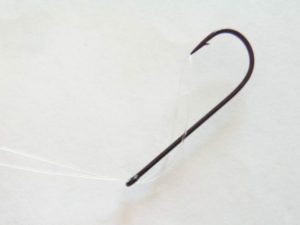
This method is a great ‘passive’ way to catch mackerel. I often set up a ‘bonus’ rod for mackerel, while I’m bottom fishing for other species at the same time. You can’t really watch the tips of your rod on the tripod and a float at the same time, so this is a great way to spread your chances. The most important part with this method is keeping the bait off the bottom.
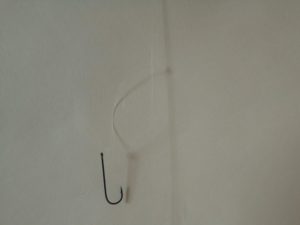
The easiest way to tie this rig is to tie it straight from the mainline, 15lb works best. Tie the weight (2oz is plenty most of the time) to the end of the line. Then tie a dropper loop at least 5ft above the weight, then tie another 2 loops above this one, about a feet apart. Loop the hooks (size 1 or 2) onto the loops and that’s it. To be able to cast this rig you need a rod of a reasonable length, like a 12ft carp rod. This method works best when fishing close in, into good depth of water.
Pros
- Perfect method when you’re feeling lazy. Bait up, cast in and sit back until a shoal hits your trace.
- Good set up for an ‘bonus’ rod. It’s always nice to catch a few mackerel when the species you’re targeting don’t play ball.
Cons
- You need to bring bait with you.
- Not very suitable for rough ground. Even though the hooks are off the bottom, the weight can still get snagged.
- Doesn’t work at a distance, because the hooks will end up on the sea bed.
- Not as efficient as the previous methods.
5. Fly fishing for mackerel
I have to admit I’m not much of a fly fisherman (I mainly hook into myself or things in my surroundings) but a friend of mine has a lot of success with this method. Fly fishing for mackerel is only possible when the fish are close in and the weather is very calm. It can be extremely effective when the mackerel hunt in shallow water, as you can see in this video.
Pros
- Very effective in shallow water.
- Great sport.
- No need to bring a lot of tackle.
Cons
- Only works in calm conditions when the fish are very close in.
Other mackerel fishing tips
Finding the mackerel
Mackerel are fairly easy to catch, but you have to find them first. Mackerel like to hang around close to structures where it’s easier to ambush their pray. Breakwaters, piers and rock marks are good spots to fish for mackerel. When the mackerel are hunting near the surface they are quite easy to spot. Just look for the baitfish jumping at the surface. When you cast into a shoal of hunting mackerel it’s very hard not to catch them. If there are no clear signs of hunting mackerel I tend to look for shoals of sprats near the water’s edge. Once you’ve found the sprats, the mackerel are usually not far away.
When to fish for mackerel
As I described in this post the fish have to be there to be able to catch them. Where I live the mackerel only show up towards the end of June. Targeting them before that is usually a waste of time. When they’re there you can catch mackerel pretty much during all daylight hours. The last hours before sunset can be especially productive. If you don’t have much sea fishing experience and don’t want to give up fishing after the mackerel disappear, read my tips for beginners.
Hook size
Mackerel have small mouths so if you miss a lot of bites, go down a hook size or two. Depending on the size of your bait, you can go down to a size 4 or even 6.
Handling mackerel
If you want to keep mackerel for the pot or for bait, dispatch them straight away. A firm knock on the head with a priest works best. Another way to dispatch mackerel is to break their neck. Put your thumb in the fish’ mouth and the rest of your hand at the back of its head and ‘fold’ its head towards its back. It might sound cruel, but it’s one of the most humane ways to kill them.
Catch and release
Some people claim that mackerel will die within 24 hours after being touched by humans because they lose the protective mucus on their scales. I doubt that’s entirely true, but it is true that the skin of the mackerel is quite delicate. When you hold a mackerel with dry hands, you’re likely to remove a lot of scales and that can’t be good in any case. So when handling mackerel – or any fish you want to release – always make sure your hands are wet.
If you can avoid holding the fish altogether, even better. If you’re close to the water, you can simply ‘shake’ the fish of the hook. The easiest way to do this is by holding the hook at the bend (upside down) with a forceps or pair of pliers. For catch and release purposes barbless single hooks are the best. They do the least damage and are easy to remove.
Mono or braid? Which line do you prefer and when? Share your experiences in the comment sections below!
And if you’d like to receive an email every time I publish a new post, please subscribe to my newsletter. Tight lines!
Disclosure: if you purchase anything using the links in this blog post, I might make a commission. Affiliate programs and affiliations include, but are not limited to, the eBay Partner Network. It doesn’t cost you a penny more to buy via these affiliate links (and you don’t have to use them of course) but it helps me to keep this blog going. Thanks!
8 thoughts on “Mackerel fishing – 5 ways to catch mackerel”
Great tips for learners like me
Thanks, happy to help.Tight lines!
Thanks for this
I always game fished but I’m only recently getting interested in sea fishing. Ill try out these great tips.
Thanks
Thanks for your comment, hope you enjoy it!
Just beginning to salt water fish , love live bait fishing .Thanks for the tips .
You’re welcome, enjoy your fishing!
Going spinning in Suffolk surf next week. these tips are great. thanks
Thanks for your comment. Tight lines in Suffolk!